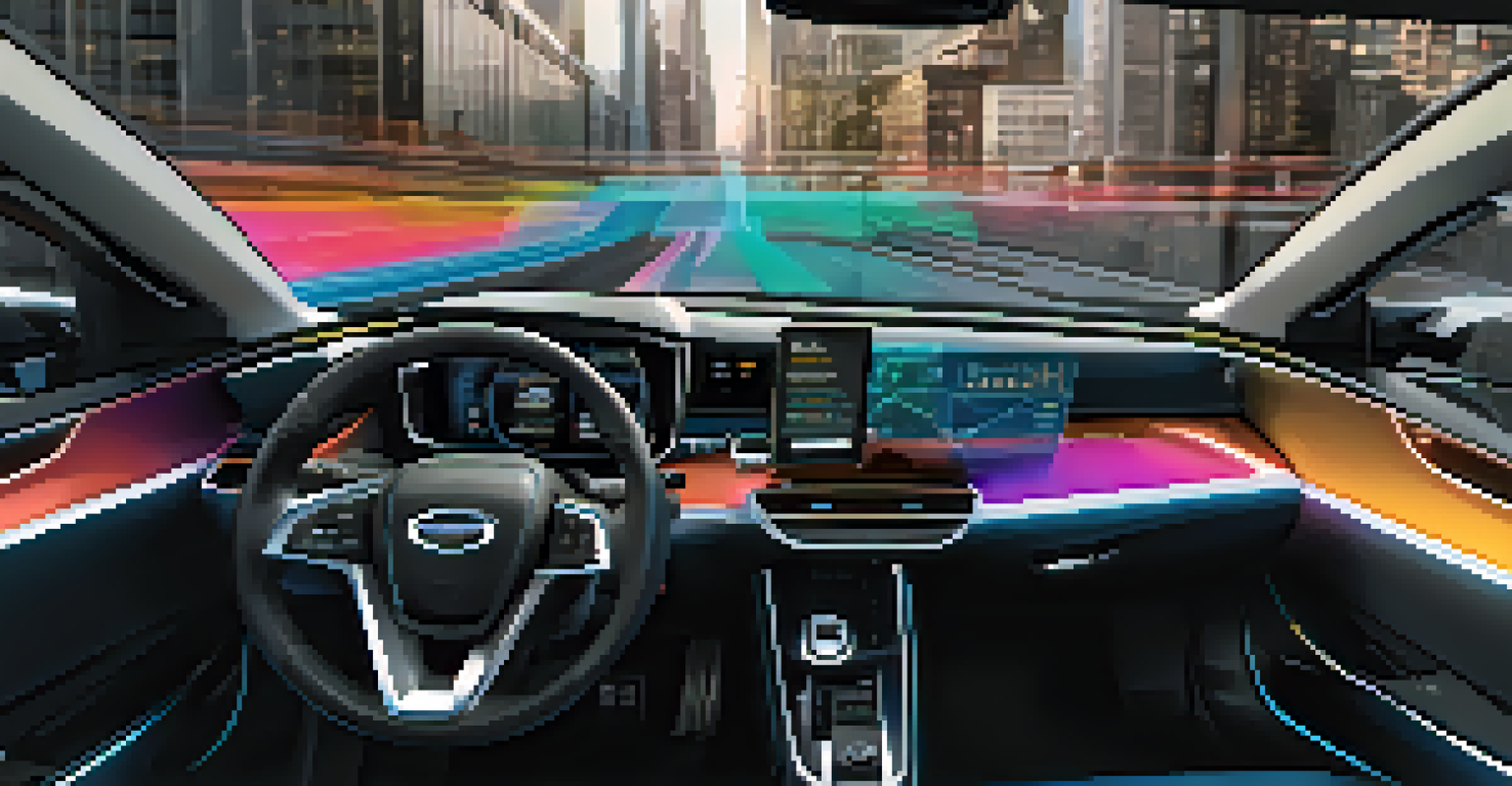IoT in Transportation: Revolutionizing Logistics and Delivery

Understanding IoT and Its Role in Transportation
The Internet of Things (IoT) refers to the network of connected devices that communicate and exchange data. In the context of transportation, this technology enables vehicles, cargo, and infrastructure to interact seamlessly. Think of it like a conversation happening between your car and your smartphone, where real-time data is shared to enhance efficiency.
The IoT is the next step in the evolution of the internet, and it will change the way we live and work.
This interconnectedness allows for smarter decision-making in logistics and delivery systems. For instance, delivery trucks can adjust routes based on traffic conditions or weather forecasts, minimizing delays. By harnessing IoT, transportation businesses can streamline operations and improve service.
Moreover, IoT devices can monitor the health and performance of vehicles, alerting operators to maintenance needs before they lead to breakdowns. This proactive approach not only saves time but also reduces costs associated with unexpected repairs. Overall, understanding IoT is the first step towards appreciating its impact on transportation.
Enhancing Supply Chain Visibility with IoT
One of the most significant advantages of IoT in transportation is enhanced supply chain visibility. With real-time tracking of shipments, businesses can monitor their goods from start to finish. Imagine knowing exactly where your package is at any moment—this level of transparency builds trust with customers.

IoT devices, such as GPS trackers and RFID tags, provide detailed insights into the location and condition of cargo. This information helps companies make informed decisions about inventory management and delivery schedules. For example, if a shipment is delayed, businesses can notify customers promptly, improving overall satisfaction.
IoT Enhances Transportation Efficiency
The integration of IoT technology allows for smarter decision-making in logistics, optimizing routes and improving operational efficiency.
In addition, this visibility allows for better risk management. Companies can quickly identify potential disruptions, such as traffic jams or accidents, and adapt their strategies accordingly. By leveraging IoT for supply chain visibility, businesses can enhance operational efficiency while reducing stress.
Improving Fleet Management with IoT Solutions
Fleet management is another area where IoT is making waves. By using connected devices, companies can monitor vehicle performance, fuel consumption, and driver behavior in real time. Picture a coach keeping an eye on his team during a game, adjusting tactics based on their performance; that’s what IoT does for fleet managers.
The future of transportation is not just about moving people or goods; it's about moving information.
This data-driven approach allows for optimizing routes, reducing fuel costs, and improving driver safety. For instance, if a driver is speeding, the fleet manager can intervene to ensure safer driving practices. Additionally, analyzing data can reveal trends, helping businesses make long-term improvements.
Furthermore, IoT can help automate routine tasks, such as scheduling maintenance or inspections, thus minimizing downtime. This means vehicles spend more time on the road and less in the shop. In essence, IoT transforms fleet management into a proactive rather than reactive process.
Boosting Safety and Compliance in Transportation
Safety and compliance are paramount in the transportation industry, and IoT plays a crucial role in enhancing both. With connected devices, companies can monitor adherence to regulations and safety standards in real time. For instance, sensors can detect if a driver is fatigued, prompting alerts to prevent accidents.
Additionally, IoT helps businesses maintain compliance with regulations such as the Hours of Service (HOS) rules for drivers. By automatically tracking driving hours, companies can ensure they are not exceeding legal limits, thus avoiding hefty fines. Imagine a digital watchdog that keeps your operations in check; that’s the power of IoT.
Real-Time Supply Chain Visibility
IoT provides businesses with real-time tracking of shipments, enhancing transparency and customer trust.
Moreover, data from IoT devices can be used for training and improvement. By analyzing incidents and patterns, companies can develop targeted training programs for drivers, focusing on areas that need enhancement. This proactive approach leads to safer roads for everyone.
Reducing Operational Costs with IoT Technologies
Implementing IoT technologies in transportation can lead to significant cost savings. With real-time data, businesses can identify inefficiencies and eliminate waste, much like a chef optimizing a recipe to reduce excess ingredients. For example, smarter route planning can decrease fuel consumption and reduce overall expenses.
Moreover, by predicting maintenance needs, companies can avoid costly repairs and extend the lifespan of their vehicles. This predictive maintenance is akin to catching a cold early with the right medicine—preventing larger health issues down the road. In turn, this leads to more reliable service, which can enhance customer satisfaction.
Additionally, IoT can streamline inventory management, ensuring that businesses only stock what they need. This reduced overhead allows companies to allocate resources more effectively, contributing to improved profit margins. In summary, the financial benefits of IoT in transportation are substantial.
Enhancing Customer Experience through IoT
In today’s competitive market, customer experience is king, and IoT is helping transportation companies deliver on this front. With real-time tracking and notifications, customers can stay informed about their shipments’ status. It's like having a personal concierge who keeps you updated on your every request.
This transparency not only builds trust but also empowers customers to make informed decisions. For instance, if a delivery is running late, customers can adjust their plans accordingly. This level of service is becoming the new standard in logistics, thanks to IoT.
Cost Savings and Predictive Maintenance
Implementing IoT technologies can lead to significant cost reductions through predictive maintenance and efficient resource management.
Moreover, enhanced customer experience leads to increased loyalty. When customers feel valued and informed, they are more likely to return to the same service provider. Thus, by integrating IoT, transportation companies can foster stronger relationships with their customers.
The Future of IoT in Transportation and Logistics
Looking ahead, the future of IoT in transportation and logistics is filled with exciting possibilities. As technology continues to advance, we can expect even more innovative solutions that enhance efficiency and safety. Imagine a world where autonomous vehicles communicate seamlessly with traffic signals, optimizing traffic flow and reducing congestion.
Moreover, the integration of artificial intelligence (AI) with IoT could lead to smarter decision-making. AI can analyze vast amounts of data from IoT devices, identifying patterns and making predictions that humans might miss. This synergy could revolutionize how transportation operates, creating a more responsive and adaptive system.

However, with these advancements also come challenges, such as data security and privacy concerns. As we embrace IoT, it is essential to address these issues to ensure a safe and efficient transportation ecosystem. The future is bright, and the potential for IoT to transform the industry is limitless.